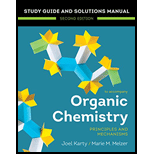
Concept explainers
Interpretation:
The complete and detailed mechanism and products for an
Concept introduction:
An
The carbocation intermediate formed in
Trending nowThis is a popular solution!

Chapter 8 Solutions
EBK ORGANIC CHEMISTRY: PRINCIPLES AND M
- Which mechanism will this reaction follow?arrow_forwardhelp me draw out the mechanism for both reactions HO N- -OH HO OH EtO OEt OH NH₂OH EtOTs OH K₂CO₂ OEtarrow_forwardDraw an energy diagram of the following reactions. A one step reaction with a positive AG A one step reaction with a negative AG A two-step reaction with an overall positivel-Where the intermediates are lower energy than the reactants and the first transition state is lower in energy than the second.arrow_forward
- Draw the missing reactants, intermediates, or products in the following mechanism.arrow_forwardConsider the following reactants: OH yes Would elimination take place at a significant rate between these reactants? If you said elimination would take place, draw the major products in the upper drawing area. If you said elimination would take place, also draw the complete mechanism for one of the major products in the lower drawing area. If there is more than one major product, you may draw the mechanism that leads to any of them. noarrow_forwardConsider the following reactants: Br Would elimination take place at a significant rate between these reactants? If you said elimination would take place, draw the major products in the upper drawing area. If you said elimination would take place, also draw the complete mechanism for one of the major products in the lower drawing area. If there is more than one major product, you may draw the mechanism that leads to any of them. Major Products: Oyes поarrow_forward
- If Hj is eliminated from the carbocation shown here in an electrophile elimination step, then three possible constitutional isomers can form. Draw the mechanism for the formation of all three of those products. H20 +arrow_forward1,3-Butadiene undergoes an electrophilic addition with HBr. Complete the steps in the mechanism to produce the product shown. 2) Draw both the organic and inorganic intermediate species. Include all nonbonding electrons and charges. Draw a curved arrow to convert the intermediate into the product shown. 1) Add curved arrows for the first step. -Br: H, :Br: Нзс -сн—CH2 нarrow_forwardConsider the following reactants: Br о Would elimination take place at a significant rate between these reactants? If you said elimination would take place, draw the major products in the upper drawing area. If you said elimination would take place, also draw the complete mechanism for one of the major products in the lower drawing area. If there is more than one major product, you may draw the mechanism that leads to any of them. Major Products: Oyes noarrow_forward
- For the following reactions, complete the reactions by giving what is missing. This can be either the starting material, reagent(s) or product. Draw the intermediates for each major steparrow_forwardQuestion 2 In the box below please draw the mechanism for the reaction in the adjacent box. OH OH Harrow_forwardDraw the complete reaction mechanism for the following reactions. Hint: Problem #4 will have a rearrangement. 1) но HBr OH 2) HBr 3) OH H,SO, OH 4) H,SO.arrow_forward
 ChemistryChemistryISBN:9781305957404Author:Steven S. Zumdahl, Susan A. Zumdahl, Donald J. DeCostePublisher:Cengage Learning
ChemistryChemistryISBN:9781305957404Author:Steven S. Zumdahl, Susan A. Zumdahl, Donald J. DeCostePublisher:Cengage Learning ChemistryChemistryISBN:9781259911156Author:Raymond Chang Dr., Jason Overby ProfessorPublisher:McGraw-Hill Education
ChemistryChemistryISBN:9781259911156Author:Raymond Chang Dr., Jason Overby ProfessorPublisher:McGraw-Hill Education Principles of Instrumental AnalysisChemistryISBN:9781305577213Author:Douglas A. Skoog, F. James Holler, Stanley R. CrouchPublisher:Cengage Learning
Principles of Instrumental AnalysisChemistryISBN:9781305577213Author:Douglas A. Skoog, F. James Holler, Stanley R. CrouchPublisher:Cengage Learning Organic ChemistryChemistryISBN:9780078021558Author:Janice Gorzynski Smith Dr.Publisher:McGraw-Hill Education
Organic ChemistryChemistryISBN:9780078021558Author:Janice Gorzynski Smith Dr.Publisher:McGraw-Hill Education Chemistry: Principles and ReactionsChemistryISBN:9781305079373Author:William L. Masterton, Cecile N. HurleyPublisher:Cengage Learning
Chemistry: Principles and ReactionsChemistryISBN:9781305079373Author:William L. Masterton, Cecile N. HurleyPublisher:Cengage Learning Elementary Principles of Chemical Processes, Bind...ChemistryISBN:9781118431221Author:Richard M. Felder, Ronald W. Rousseau, Lisa G. BullardPublisher:WILEY
Elementary Principles of Chemical Processes, Bind...ChemistryISBN:9781118431221Author:Richard M. Felder, Ronald W. Rousseau, Lisa G. BullardPublisher:WILEY





